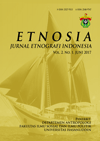Abstract
Abstract
The expansion of a new autonomous region (DOB) not only provides an arena for reproductive
power of local elites, such as politicians, senior bureaucrats and businessmen, but also provides
an access for the adatleaders to reaffirm the symbol of power attached to their heritable
nobility. This article aims to explain the process of reproductive powers of Kulisusu aristocratic
in the expansion process of North Buton regency. The reproduction of identity and power of
Kalisusu royalty in the expansion process of North Buton begun since adat leaders got involved
in the expansion of political activities in order to legitimize the emergence of North Buton
identity. To legitimize North Buton identity, adat leaders are supported by the claims that they
have genealogical relationship with their ancestors, the founders of Kalisusu royal nobility. The
involvement of adat leaders is, in fact, not on their own initiative, but by the expansion agents.
However, the involvment of adat leaders have precisely giventhem a space for reproductive
power in a new autonomous regions, North Buton. It shows how the reproduction of identity is
closely associated with theirfuture interests. The study also found that the return of the rule of
Kulisusu aristocratic into a new contestation isaimed to find the foundation of original Kalisusu
adat.
Keywords: identity reproduction, power, barata, contestation, autonomous.
References
Castells, Manuel., 2010. The Power of Identity.
California: Wiley-Blackwell.
Coppenger, Caleb., 2012. Misteri Kepulauan
Buton Menurut Sesepuh dan Saya. Jakarta:
Adonai.
Eriksen, Thomas Hylland., 1998. Antropologi
Sosial Budaya; Sebuah Pengantar.
Terjemahan Yosef Maria Florisan. 2009.
Maumere: Ledalero.
Fahmid, Mujahidin., 2011. Pembentukan Elite
Politik Di Dalam Etnis Bugis dan
Makassar Menuju Hibriditas Budaya
Politik. Disertasi tidak diterbitkan. Bogor:
Sekolah Pascasarjana IPB.
Geertz, Clifford., 1992. Politik Kebudayaan
(Diterjemahkan oleh Francisco Budi
Hardiman). Yogyakarta: Kanisus.
Hadara, Ali., 2010. Sejarah Kawasan Buton
Utara; Dari Masa Praintegrasi Hingga
Terbentuknya Kabupaten Buton Utara.
Laporan Hasil Penelitian. Kendari:
Lembaga Penelitian Universitas Haluoleo.
Hall, Stuart., 1996. ‘Introduction: How Needs
Identity?’, dalam S. Hall dan P. Du Gay
(eds.), Question ofIdentity: AReader.
London: Sage Publication Ltd., 1-17.
Heryanto, Ariel., 2015. Identitas dan
Kenikmatan: Politik Budaya Layar
Indonesia, Jakarta: Kepustakaan Populer
Gramedia.
Lan, Thung Ju, Adhuri, Dedi. S., Saifuddin,
A.F., Hidayah Zulyani., 2010. Klaim,
Kontestasi, dan Konflik Identitas:
Lokalitas vis-a-vis Nasionalitas. Jakarta:
Institut Antropologi Indonesia.
Nurlin., 2015. ‘Menyingkap Tabir Kuasa di
Tanah Buton: Orang Kulisusu, Identitas
dan Kekuasaan. Tesis tidak diterbitkan.
Makassar: Program Pascasarjana
Universitas Hasanuddin.
Rahim, Idris., 2010. ‘Identitas Etno Religius
dalam Pembentukan Provinsi Gorontalo’.
Disertasi. Yogyakarta: Program Pasca
Sarjana UIN Sunan Kalijaga.
Rudyansjah, Tony., 2009. Kekuasaan, Sejarah
dan Tindakan; Sebuah Kajian Tentang
Lanskap Budaya. Jakarta: Rajawali Pers.
Sen, Amartya., 2007. Kekerasan dan Ilusi
Tentang Identitas (Diterjemahkan oleh
Arif Susanto). Tangerang: Marjin Kiri.
Schulte-Nordholt, Henk & Klinken, Gerry van.,
‘Pendahuluan’, dalam Henk Schulte
Nordholt dan Gerry van Klinken (eds.)
Politik Lokal di Indonesia. (Diterjemahkan
oleh Bernard Hidayat). Jakarta: Pustaka
Obor Indonesia, KITLV-Jakarta, 1-41.
Suyono, Seno Joko., 2002. Tubuh Yang Rasis;
Telaah Kritis Michel Foucault atas Dasardasar
Pembentukan Diri Kelasa
Menengah Eropa. Yogyakarta: Pustaka
Pelajar dan Lanskap Zaman.





